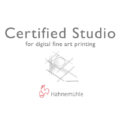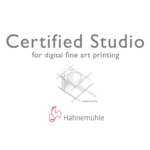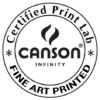Welcome to the FAQ (frequently asked questions) page
Of Fine Art Printed.
Choose the section you prefer from the following options.
What does fine art printing mean?
A fine art print is distinguishable from “normal” prints by its high quality characteristics, durability and the use of high quality print media. This is made possible by the use of special certified “fine art” printers that use a greater variety (up to 12) of the latest pigment inks than normal printers that generally have 4 or 5 types of ink. This can ensure a better match for example between what a camera has captured and the print. These features allow prints to be able to be preserved for a long time even centuries if kept with proper conservation criteria. Fine Art prints are intended for museums, exhibitions, portfolios, and to preserve your memories in the best possible way. For a more in-depth look at fine art printing click here.
What is the difference with a photographic print?
Even high-quality photographic prints have a much shorter life span than Fine Art prints. The latter properly preserved can easily exceed a century of life. Visually, Fine Art prints can be very different from photographic prints mainly because of the type of medium, which can vary from matte paper to glossy paper or even canvas. In terms of color depth and the actual ability to transfer the digital image to paper, Fine Art prints are the standard also taken into consideration by museums and art galleries.
what is a canvas print?
A canvas print is a fine art print on a canvas support. The main characteristic is the typical texture of canvas, which gives great depth to the work and makes it look as if it were directly painted on the support. In addition, canvas prints are framed like pictorial canvases. This leaves the possibility of hanging the canvas directly on the wall without the need to add a frame. Because of the frame support, canvas prints are particularly suitable for large formats.
What is the difference with a Giclèe print?
None. A Fine Art print is also called a Giclèe print. But not all Giclèe prints are Fine Art. To learn more, read here .
What is protective spray and why should I use it?
Hahnemühle Protective Spray offers incredible protection for your valuable Fine Art prints. This odorless spray seals printed surfaces and protects them from dust, fingerprints and moisture. Increases water resistance and protects image prints from fading caused by UV rays. The protective spray is quick to dry and does not yellow. It is completely transparent and has no influence on the original colors of the paper.
What is paper heaviness or GSM?
GSM (grams per square meter or g/m2) is an indication of the heaviness of a paper. Generally, the greater the heaviness, the greater the thickness. To give examples, the paper that documents are usually printed with is around 75 to 90 gsm. A book cover is around 200 gsm. High quality photographic papers are around 250 gsm. The thickness of the paper besides giving a certain value to the print is also important for the degree of color absorption, its opacity and durability. Our prints are made on high gsm papers.
Who will see my picture/work?
Uploaded files will be used with full respect for privacy and copyright. They will be used only for printing and then deleted. No one outside of the user or site staff will be able to see the uploaded files.
Are premium services provided for members?
We are currently testing the possibility of offering premium services. Visit us again or sign up for our newsletter to stay informed.
I am a professional, am I entitled to special discounts/prices?
The prices shown on the website are the prices for all Fine Art Printed customers. There is no differentiation of price ranges. Obviously, a professional customer will have the option to charge VAT on the final price according to their tax regime.
In addition, for particularly large and continuous orders it is possible to obtain a customized discount to be agreed upon.
What is the purpose of the newsletter?
The newsletter is a way to stay in touch with the site by receiving the latest product news, promotions and have the opportunity to take advantage of exclusive coupons for subscribers.
How do you order a printout?
To place an order you will need to go to the Print menu and choose the type of printing to be done. You will be able to choose between Fine Art and photographic (non-Fine Art) printing. Fine Art printing is further divided into paper printing and canvas printing. In addition, there may be a further division between glossy finish and matte finish. If you choose glossy finish, for example, you will have a list of all the types of fine art glossy finish paper available on the site. Within the individual paper you will have the ability to choose the print size and upload your image directly. You will be able to choose from standard or custom print sizes by immediately viewing the cost. By clicking on the “Add to Cart” button your file with your chosen settings will be added to your cart. Once you have added a product to your cart you will still have the option to change, update or remove it later. The next step is to click on “Proceed to Purchase.” This will take you to the billing/shipping page where you can enter your information and check the purchase summary. By clicking on “Place Order” you will be redirected to the Paypal site to finalize your payment and submit your order. If you have any questions please do not hesitate to contact us.
Below is a video showing how to place an order on the site.
How do you upload a file?
The file is directly loadable on the chosen paper page. Clicking on the “choose file” button will open a window from which you can choose the file from your computer. Once you have chosen and decided on the print settings, clicking on “add to cart” will load your image. Uploading can take for a variable amount of time depending on the speed of your connection and the size of the file being uploaded.
For particularly large files, it is possible and advisable to use services such as Dropbox or Wetransfer by directing the files to info@fineartprinted.com.
How to share files with Dropbox
To share files with Dropbox please create a folder with the client’s First Name and Last Name with folders inside divided by size. For example Folder 20×30 and folder 30×45 with the relevant files inside. Finally share with email info@fineartprinted.com.
How is my photo/work printed?
All prints are made on Fine Art paper, Canvas or Photo Paper according to the customer’s choice. All works in STANDARD format are printed with a standard 1 cm white border so that they can be framed in the future and a passepartout can be used. It is still possible to choose the medium or large border of relatively 3 or 5 cm. Should you wish to make mounts, you will be able to request them directly from the order page by selecting “Advanced Options.”
Are the prices including or excluding VAT?
As of January 2021, the prices shown on the order forms on the website and in all parts where it is not otherwise indicated are to be considered VAT included.
In the shopping cart you will be able to see the amount of VAT of your order.
What are the payment methods?
The main payment method is Paypal. This ensures secure and fast transactions for both you and us. It is also possible to make payments by Bank Transfer. In case of special needs please contact us at the email: info@fineartprinted.com
Is there a minimum order quantity?
Due to the needs of roll optimization, avoiding too much waste, and allowing even the small size to be made, a minimum order has been introduced. An error message will appear within the cart if the minimum order is not exceeded.
Can I purchase and have a third-party customer ship?
Of course. If you need to ship to a third person, whether a customer or otherwise, simply enter a different shipping address than the billing address.
When will my prints be made?
As soon as payment is completed the order will be placed and as soon as possible the prints will be prepared. In case of delays or particular times of the year, we will contact you to inform you. Except in rare cases, prints will be made within a few working days of the order and shipped as soon as they are ready.
How will the printouts be shipped?
Prints depending on the size and type of paper will be shipped inside cardboard panels, rigid tubes protecting them with acid-free tissue paper (for lighter weight prints) or in polyethylene or rigid cardboard envelopes to prevent them from being damaged in transit.
Packages are shipped via TNT Courier, UPS or Bartolini and shipping has a fixed cost of 15€. All shipments are insured. For particularly large parcels or wooden crates, shipping may be increased as needed. It is also possible, by appointment, to pick up orders directly at our workshop at no additional cost.
Where is my order?
Depending on the type of order, timelines can be very different. It is recommended that orders be submitted well in advance of a possible deadline so that there is ample time for processing. As long as the order is reported as “in processing” it means that it has been taken care of and is waiting to be completed. Once marked as “completed” it means the order is ready for shipment.
What files can I print?
Uploadable files are those with the extension .jpg, .jpeg, .tif, .tiff , .cr2, .raw . Through the upload form you can upload files up to 100 MB. For larger files please contact us. Respect for the property of others is of absolute importance. You cannot print photos of others or of which you do not hold the copyright. In case of suspicious uploads, the administrators will contact you to ask for an explanation or close your account.
Do I have to have a calibrated monitor to prepare the files?
It would be advisable to always work with a calibrated monitor. The best way to optimize the files is to prepare them for the chosen paper. This can be done through a softproof that will give us an idea of how the print will look. Clearly this is a simulation and should be treated as such, but it can be useful in understanding how a particular paper will behave with colors or dark areas. Since it is therefore all based on the actual color you see on the screen, making an adjustment or postproduction to prepare a file on an uncalibrated monitor will undoubtedly lead to unpredictable results. The essential requirement then for optimizing a file for printing is to have a calibrated monitor.
To download card color profiles and how to make a softproof, go to this page.
How should I prepare my files?
Since Fine Art prints are high quality prints, the file must also be of high quality to achieve an optimal result. This means that the files must have adequate resolution to be printed. We recommend that you send files with a resolution of at least 300 PPI at the size you choose for printing.
We will check the quality of the files when printing and if in doubt we will contact you to find out how to proceed.
For convenience you will need to set the color space to Adobe RGB(1998).
How to figure out up to what size I can print a file?
The files should be printed at 300 ppi in the print format. This means that a 300 ppi 20×30 file is larger than a 300 ppi 15×20 file. The ppi are the density of pixels per inch. The more the better but clearly the ratio there is between image pixels and ppi gives the optimal print size.
How to comply with print proportions and dimensions?
Files must be sent in the correct proportions with respect to the order. This means that if a file is square, the dimensions will have to respect these proportions.
If you use 2:3 ratio sensors it means that you can safely print classic formats: 20×30, 30×45, 40×60, 50×75 and so on.
If using 3:4 ratio sensors means that you can safely print classic formats: 30×40, 60×80, 40×60 and so on.
Of course, all intermediate sizes will also be printable while not being standard. The important thing is to match the image proportions to the order size.
If the proportions do not match, the image will be printed within the dimensions ordered. The outer white border, if any, will instead comply with the dimensions chosen when ordering.
Example: Order a 50×70 cm print + border 1 and send a file with 3:4 proportions. The file by adapting the short side to 50 cm will be printed with long side 66.67 cm while the outer sheet size will be 52×72 cm.
How can I tell what my prints will look like?
Like all prints even Fine Art prints can have different colors than those displayed on the screen. First of must know that to get a better match you need to use proper color profiles for both the screen and the printer. This means that to better evaluate colors you will need a calibrated screen. A calibrated screen is nothing more than a screen whose colors meet certain standards and therefore can produce images comparable to other screens that follow those standards. We use calibrated screens to check your files. Our printers are calibrated with specific color profiles for the paper-printer pair. This means that depending on the paper you choose, we will use the specific profile for that paper.
Fine Art prints are the result of the choice of paper and the color space (gamut) it comes from. This means that Fine Art printers and Fine Art papers are able to represent a greater color space than normal printers but still less than the common color spaces that digital cameras use. The gamut of a device or peripheral, an English term derived from Middle Latin gamma-ut which indicated a scale of notes, is the set of colors that the device or peripheral is capable of producing, reproducing or capturing and is a subset of the visible colors. To check the actual color of the print you will order, you can do a screen test by using the color profiles of the papers you use. These profiles are generally available at paper mill sites.
How can I optimize my files?
The papers we use all have icc profiles for color management. Through these profiles you will have the ability to make soft-proofs to display a simulation of a print on the screen. You can download the profiles and understand how to install them on the dedicated page. For more information on how to make a soft-proof contact us at: info@fineartprinted.com.
What color space should my files have?
It is preferable that they are already set to Adobe RGB (1998). Adobe RGB (1998) color space is the most suitable color space in terms of size and amount of colors for high-quality digital printing. Working with sRGB color space will result in a loss of upstream colors that cannot be recovered in print. Working with a ProPhoto RGB color space, on the other hand, will result in us working with colors that are not printable with any human technology, so it is a color space not suitable for the purpose of printing. Files with other color spaces will still be converted to Adobe RGB to optimize printing.
How to prepare a file for printing on canvas?
Print with colored sides
Canvas printing with colored sides is a process that allows the continuation of the image to be shown around the frame. This means that the image will not be cut off but will extend outside the chosen frontal area. It is advisable to avoid having essential elements of the image near the edge to prevent them from being hidden due to the processing. In order to understand what will be outside the print area you can follow this example:
Printed on 50×70 cm canvas with colored sides. Since the normal frame is about 2 cm thick the image will be printed about 2.5 cm more per side. It means that the printed image will be 55×75 cm. With Photoshop it is very easy to figure out which area of the image will be on the front by using guides placed 2.5 cm away from the 4 sides. This will also make it easy to tell if there are any essential elements that will need to be cut out.
Print with white sides
Printing on canvas with White sides is much easier to prepare. The printing area perfectly matches the dimensions of the frame. It is very important in this case to send the file of the perfect size of the chosen frame to avoid any cuts.
Didn’t find what you’re looking for? Contact us









